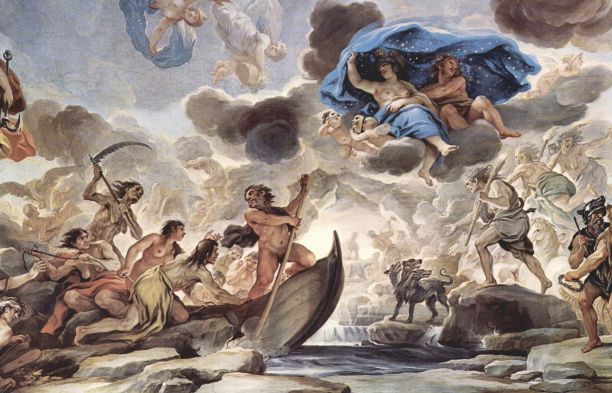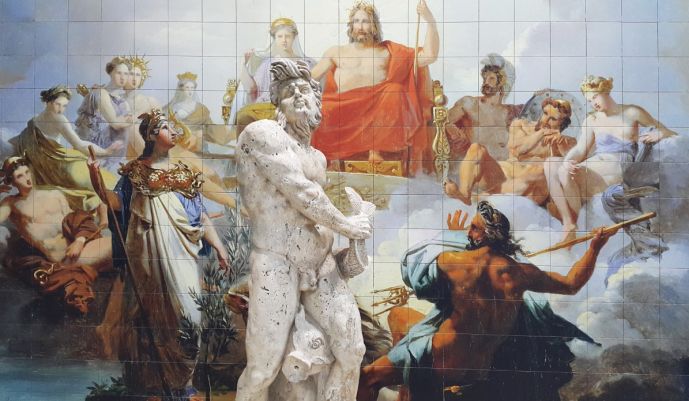Greek Painting – History of Murals, Characteristics and Advantages
Contents
What is Greek Painting?
Greek Painting has survived mainly as ceramic decoration. The few surviving Greek murals are remarkable. However, it shows important advances in techniques of realism (shading and perspective). Likewise, the heart of Greek culture (of painting) was Athens. This is true even at the time of Greek obscurantism, during which Athens (like all other Greek settlements), was to grow into a city (see history of Greek Europe). Therefore, apart from painting, the main form of ancient graphic art (two-dimensional visual art) was the mosaic.
Mycenaean civilization collapsed, possibly due to civil strife, in 1200 BC. Thus began the Greek dark ages, during which the Aegean region languished in deurbanized poverty. However, this period witnessed the development of the protogeometric style, with concentric circles and patterns of straight, undulating zigzag lines.
The precision of the protogeometric style is distinguished from earlier forms of geometric decoration. This reflects technological innovations, i.e., the multi-headed brush (for painting parallel lines) and the compass (for painting circles). Thus, the impact of protogeometric decoration is often accentuated by its scarcity.
Definition of Greek Painting
The Archaic period encompasses three phases of Greek painting: Geometric painting, Orientalization and Black Figure painting.
The geometric style would have elevated geometric decoration to new levels of complexity. A geometric style vessel offers a variety of patterns, such as checkerboards, repeating and meandering shapes. (A meander is a pattern formed by a single continuous line). If there are human or animal figures, these are rigid are stylized to blend in with the pure geometric elements.
The next phase of Greek painting is known as Orientalization, due to its adoption of images from Eastern lands (lions, sphinxes). Orientalization in ceramic decoration can be divided into two main styles. The bold and luxurious proto-Athenian style, well adapted to large jars, to which essentially geometric style adds large figures. The delicate proto-Corinthian style of Corinth, on the other hand, which features small figures and light geometric elements (e.g. rosettes), ideal for small vessels.
How did Greek Painting develop?
The Orientalization period was succeeded by the black-figure style, in which the silhouettes of the figures are painted in solid black (usually on a vibrant orange background); details are added by cutting lines in the silhouettes.6 Other paint colors are sometimes used for accents. The black-figure period marks the beginning of narrative scenes in Greek ceramic decoration (i.e., scenes that tell a story; see realism and stylization); these scenes are usually framed with geometric elements.
The Archaic period also witnessed the rise of Greek wall painting, which (during the Archaic period) featured a flat, sharply outlined style of which a few examples survive. The finest collection may be that of the Tomb of the Diver, discovered in a Greek settlement in southern Italy.
Greek mural painting was adopted by the Etruscans of central Italy, who used it to decorate the walls of their own tombs.10 Excavated in rock, since the Etruscan painting style was firmly based on Greek, these tomb murals (of which many more survive of Greek murals) provide a valuable glimpse into Greek painting.
What is the importance of Greek Painting?
Greek painters were always concerned with the same issues in the sense that the subjects were almost always the same. In the Bronze Age they painted battles between men and their enemies. In the classical period, Greek pottery shows, once again, scenes of the struggle between order and chaos, i.e. men fighting monsters, satyrs drinking and feasting. But the paintings, which most often depict gods, also show that for the Greeks, the gods were often the same, the forces of chaos, the religious ritual of man’s effort to control the gods and the forces in the realm of reason.
What is the legacy of Greek Painting?
Among the many influences of ancient Greece is art. The ancient Greeks were the first to develop the standards of aesthetic beauty that are still used today. Although the Greeks painted beautiful clay vases and statues, the greatest influences are in both painting and sculpture. During the classical era, artists made incredible innovations that went beyond previous rigid styles, such as the art of ancient Egypt. Realistic Greek figures and paintings were designed with mathematically precise proportions, modeled in intricate approaches, meaning that with geometric formula the Greeks used to craft ideal standards of beauty and perfection. Likewise, the Greeks may have lived more than 2,000 years ago, but they left a lasting legacy that still affects Western culture and way of life. During the height of Greek civilization, Greek culture spread throughout the Mediterranean. It was later imitated by the ancient Romans. After the Middle Ages, the European Renaissance incorporated many aspects of Greek culture. As a result, today the effects of ancient Greece can be seen throughout the world.
Who are the Most Important Greek Painters?
The most famous painters of the 5th century Greek classic were: Apollodorus, who was studied for his technique (Skiagraphia), which is a primitive type of chiaroscuro. Another Greek painter, a disciple of Apollodorus, the great Zeuxis of Heraclea, known for his easel paintings and for the technique called in French (trompe l’oeil), is also reported in the literature. Likewise, Agatharchos is reported as a Greek painter, considered a pioneer of large-scale graphic perspective. Also mentioned is Parrasio, who was well known for his drawings and his images of Theseus in the Capitol in Rome. Timarete, another of the greatest Greek women’s painters, is noted for a panel painting in Ephesus of the goddess Diana.
The Late Classical period (400-323 BC) saw the flourishing of the Macedonian Empire under Philip II and his son Alexander the Great. Thus, Athens remained the dominant cultural center of the continent of Greece. This was the high point of ancient Greek painting, with artists such as the talented and influential Apelles of Kos, who was the official painter to Philip II of Macedon and his son Alexander the Great, famous for adding new techniques of relief, shading and coloring.
Other famous artists of the fourth century include other painters (some considered rivals of Apelles, such is the case of Antipholus, specialist in light and shade, genre painting and caricature) and Protagenes who stands out for his careful finishing. Euphranor of Corinth, a purely classical artist who excels in painting and sculpture. Eupompus, considered the founder of the school of Scion, and the historical painter Androkydes of Cicicum, known for his controversial history painting depicting the battle of Plataea.
On the other hand, it is considered that the real tragedy of Greek art is the fact that much of it has disappeared. Thus, only a very small number of temples, such as the Parthenon and the temple of Hephaestus, have survived. Likewise, Greece built five wonders of the world, such as the Colossus of Rhodes, the temple of Artemis at Ephesus, the statue of Zeus at Olympia, the Mausoleum of Halicarnassus and the lighthouse of Alexandria, however, only the ruins and fragments of these buildings have survived.
Similarly, the vast majority of sculptures have all been destroyed. Likewise, Greek bronzes and other Greek goldsmiths’ works, especially, were melted down and turned into tools or weapons, as were the stone statues that were looted or broken down for use as building material. Likewise, approximately 99 percent of all Greek paintings have also disappeared.



